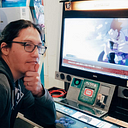Mind Your Hands
[This essay was funded by my generous Patreon supporters. If you liked this and want to see more, please consider joining the crew!]
Fighting games are physically difficult to play, and controlling a fighting game character doesn’t come naturally to anyone. You will feel clumsy and off balance at first, just like a new martial artist, and as you practice and grow you will feel your character move with a sharp grace that reflects your improvement, making your will manifest on screen. It is our hands that tie our brains to our characters, and it is this connection that makes the moments where you lose control feel like you’re taking the hits yourself.
I say this as a player who has never considered execution a strength: I love that fighting games are physically difficult to play. This difficulty teaches us that it is not enough to know the answer; you must do the answer. All that matters in the fight is what you can do. (Also, watching people do hard stuff is way more hype than watching people know hard stuff.)
I find that too many players think of execution as a question of “What” — as in, “What inputs are my hands performing?” — when they should be thinking of it as a question of “How are my hands performing these inputs?”
As in: How you hold your controller; which fingers you’re using to push the stick or the angle of your thumb on the pad; where you use your wrist or your palm or your shoulder (shoutouts to MAS sticks); how and when you return to neutral. These things all matter. The only right way is the one that works.
Pay attention to your hands. Remember to coordinate your left hand with your right hand; do not press the button until the directions are in.
Listen to the music your buttons make when you hit your combos and use that to order and synchronize your directional inputs. If you don’t know what your combo is supposed to sound like, listen to someone else do it, or listen to the hit sounds of a dummy recording/video and work backwards from there.
Making subtle changes in timing button presses is hard. It’s not easy to consciously think “I will press this button two frames later”. It can be easier to simply change the height you’re holding your finger above the button to give yourself more or less travel time.
When you’re doing something that requires precise stick inputs, try using your fingers more than your palm or your wrist; your fingers are probably better at remembering subtle nuances in timing. However, if you need to quickly change from a push to a pull, or vice versa, then you may find your palm and wrist more reliable for bigger, faster movements.
If you know you’re pressing a button in specific situations that you shouldn’t be pressing it in, stop holding your finger over that button in those situations. Make it easier for your hand to press the button you should be pressing. (Or stop pressing buttons.)
Practice doing your complicated stuff slowly, cleanly, and quietly, using minimal effort with meticulous precision. Use training mode to sharpen your clean, attentive execution. Assume that when you’re competing you’ll be at 50–80% execution. Make your 80% better than your opponent’s 100%.
Learn the clean way to do the combo, then add the special stuff to the areas where you find you drop things. Look for timing tricks and shortcuts to make your mixups consistent. Find out that foot position or hand angle or hold your breath or double-tap timing that lets you get an extra 5% more accuracy. Piano your supers.
When you’re having a hard time getting the thing you want to come out, learn to let go. I mean actually let go of the stick and buttons to go to neutral. Sometimes you just need to take a couple frames to clear your input buffer.
Stretch your wrists when you’ve got a spare moment or two. Be nice to your hands, they do a lot for you.
Practicing in the posture you use for tournament matches is important; you want to practice in the conditions that you compete in. But playing in different conditions — controllers, positions, displays, whatever — will push you to learn your execution from different angles. Sometimes a sequence won’t click on the stick until you do it on a keyboard. It’s good to have that practice, too.
There is joy in teaching your body to do something new and difficult. It’s there when you feel that new combo click in tournament, when you play your old main from your first game, when you jam something out mid-match that you didn’t realize you knew how to do. We play fighting games like we play music.
—
Thanks for reading!
💪😎👍❤
-patrick miller
